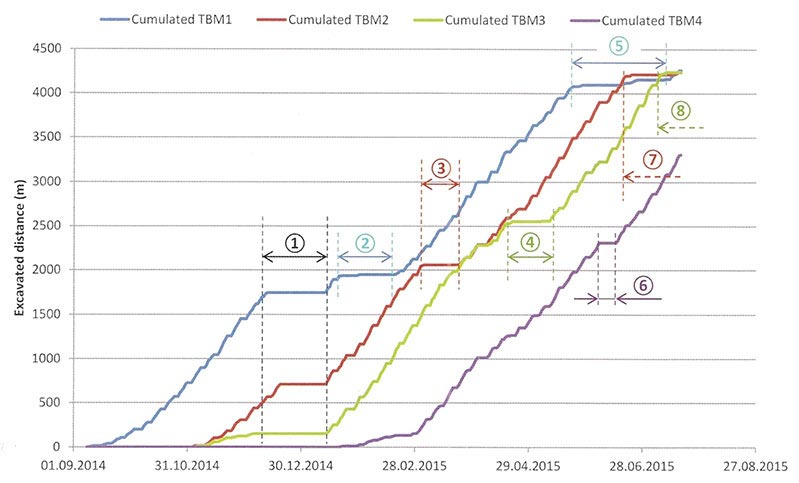A recurring theme during the 2015 Eurock conference and Salzburg Geocolloquium in Austria recently was the connection between rock mechanics, geomechanics and mechanical excavation using full-face TBMs. There is no doubt that new-generation TBMs, and their potential for rapid excavation, grab the attention. But while the world’s handful of TBM manufacturers are confident in the ability of added innovations to improve performance of their machines, there was a general opinion among project owners and some contractors at the conference that more research of existing TBM capabilities is needed to provide a firm foundation upon which new ideas and developments can be built.
In their presentation, for example, the members of Strabag Contract Management accepted that “we are in an era of high speed technical development” and that “knowledge stems from the permanent interaction between research and practice” but that, as a result of the “typical S-curve between universities and committees establishing standards and them being implemented in practice”, a wider knowledge gap exists for rapidly developing mechanised tunnelling within the development timescale of major projects than in the same period for the more well established drill+blast conventional tunnelling (Fig 1). To reduce this gap, they attest, “various experts must be engaged during the project implementation to complete research on boundary conditions” and that this has “an impact on the agreed contractual terms and construction process” through the project.
In the opening keynote presentation of the technical sessions on Thursday morning, Prof Wulf Schubert of Graz University and President of the Austrian Society of Geomechanics, also warned of the overexpectation of TBM performance in light of the need for more research into the application of mechanical excavation in different rock types and conditions. Much discussion then followed about the advantage of double shield TBMs in competent rock conditions. Does the double-shield concept guarantee high production through their ability to mine and line simultaneously? Or is the concept the necessary basis of a machine that can cope with both hard rock as well as softer, less stable, conditions, while at the same time providing a segmental initial or one-pass lining?
To collect the information and provide material for research studies to present findings and answer these questions there are many current double shield TBM projects in the world today, one of the largest and one of the newest being in Austria itself. There are three double-shield TBMs (two Wirth and one Herrenknecht) working on the long Koralm high-speed railway tunnel project between Graz and Klagenfurt, while two new Robbins double shield TBMs are bringing the US company’s long-standing pedigree for hard rock TBM tunnelling expertise back to the European Alpine region for excavation of the 22km long GKI hydro-scheme headrace near the mountain town of Pfunds. The project location is above Innsbruck and in the neighbourhood of the Brenner Base Tunnel, which has itself used double shield TBMs for exploratory tunnels and is sure to engage more TBMs for the main tunnel bores.
TunnelTalk made a technical visit to the GKI project in Pfunds with Robbins and to the Koralm project as part of the post conference technical tour and will report more on both shortly.
Two other major double shield TBM operations currently in the world are:
In his presentation, Thomas Camus, Manager of R&D at NFM Technologies, gave a presentation on the application of the four NFM double shield TBMs on the North West Rail Link project in Sydney. For a double shield operation, progress appeared to be below optimum, but, as Camus explained, there were many causes for interruption of excavation progress.

Whereas double shield rates of 850m as a 30-day maximum, and near 800m as monthly averages, were recorded for the two Herrenkencht double shield TBMs that worked on the Legacy Way highway tunnel project in Brisbane, the four Sydney TBMs are being held up by the highly abrasive Hawkesbury Sandstone though which 60% of the twin tube tunnels are aligned. They are also interrupted by the three shifts/day five days/week production schedule with maintenance only on the two weekend days each week (Fig 2). The Sydney TBMs are reported to have been working continuously in double shield mode since being launched but cutter consumption through the sandstone is predicted at between 350–690m3/disc, depending on design and supplier, which is requiring frequent downtime for cutter changes.
For research institutions there is a wealth of opportunity for study and development in the field of TBM tunnelling covering not only the metallurgy and operation of disc cutters and TBM fabrication and equipment, but also in the study of geomechanics and the process and ability of TBM systems to excavate rock types and conditions. The details of these studies will no doubt find opportunity to present results and findings at future sessions of the Salzburg Geocolloquium.
|
|
|
|
|